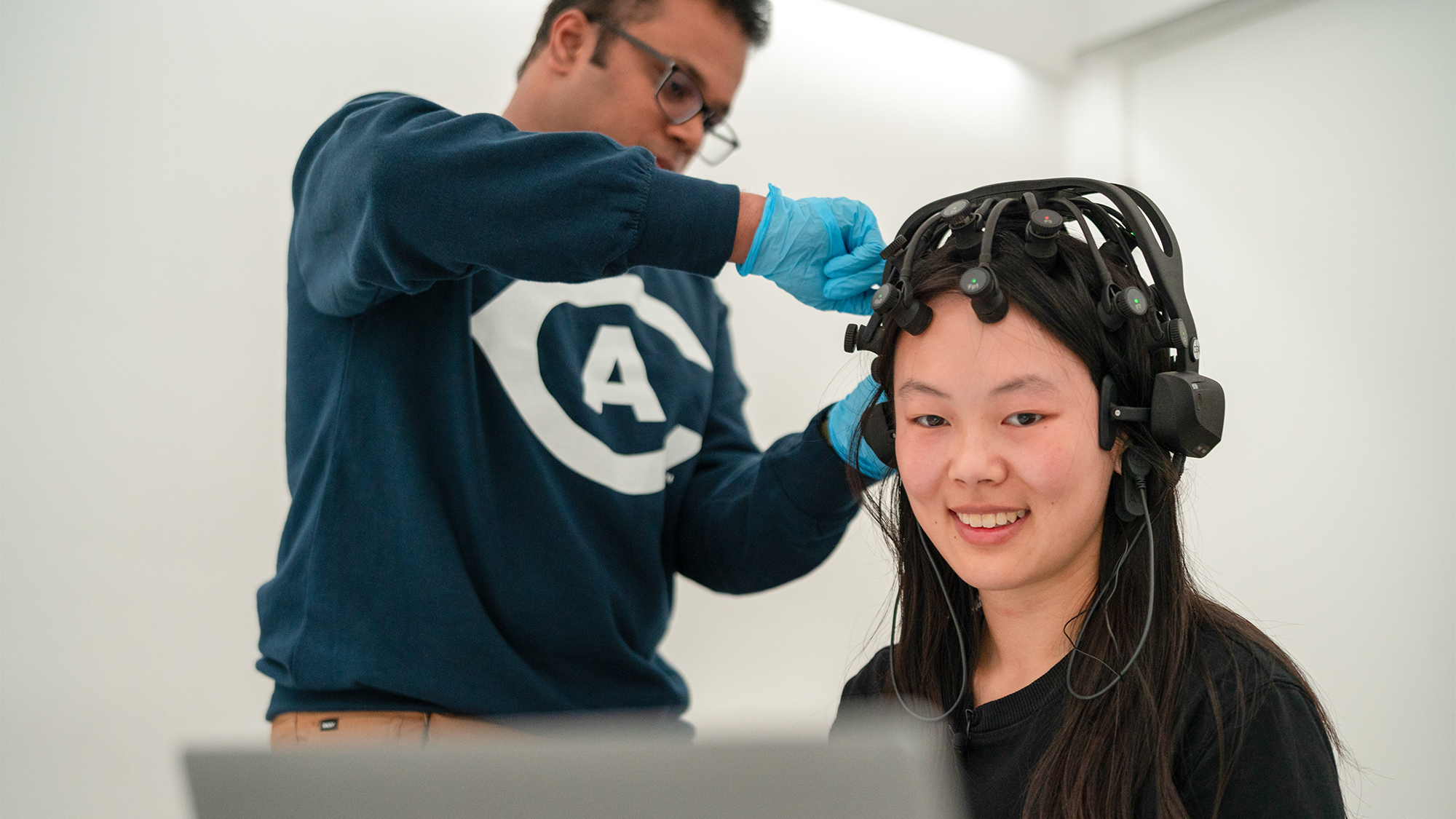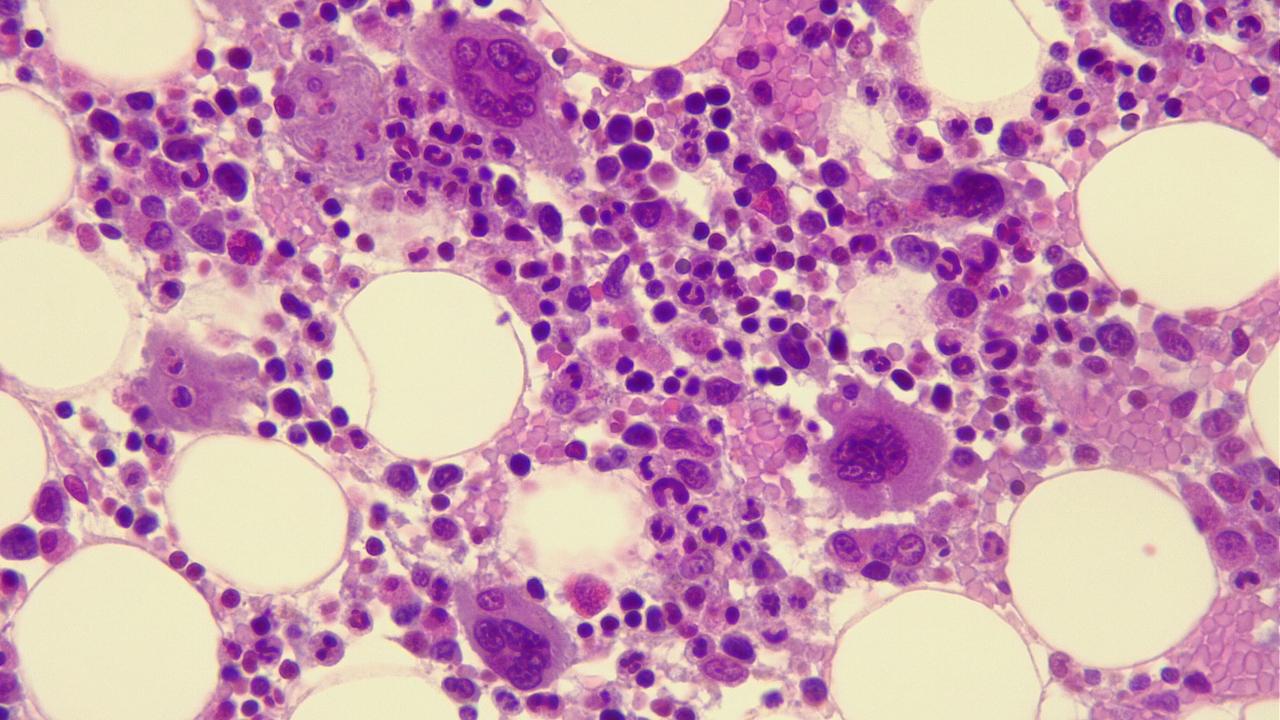Quick Summary
- Researchers from UC Davis and Lawrence Livermore National Laboratory developed and studied a new material — engineered bone marrow, or eBM.
- Engineered bone marrow offers a better way to study osteosarcoma, a type of bone cancer, and safely test new treatments.
- This work could improve individual treatment therapies for anyone with osteosarcoma and can especially help children and dogs.
The From Labs to Lives Blog connects everyday topics with UC Davis research. Each post is reviewed by our experts, ensuring you always get useful information you can trust.
How is bone marrow related to cancer?
Cancer can start in the bone marrow, where your body makes blood cells.
Some cancers, like leukemia and lymphoma, begin when bone marrow stem cells become cancerous. Other cancers can travel from different parts of the body and spread to the marrow.
When cancer takes over the bone marrow, it stops working normally. Instead of making healthy blood cells, the bone marrow fills up with abnormal ones. This crowds out the good cells your body needs.
Some symptoms/results of bone marrow cancer are:
- Developing anemia
- Getting sick more often from infections
- Experiencing fatigue and bone pain
- Facing a higher risk of fractures
Understanding the bone marrow environment is key to improving care for certain cancers.

From Labs to Lives
At UC Davis, our research helps people like you. Federal funding helps us move discoveries from our labs to your community faster. Learn how you can support life-changing research.
What is osteosarcoma?
Osteosarcoma is the most common primary bone cancer in children and adolescents; it usually affects kids under age 13.
In about 25% of patients, this cancer spreads to the lungs. For children with metastatic cancer, the five-year survival rate is less than 25%.
In other words, out of every four children whose osteosarcoma spreads, only one child (or fewer) is expected to still be alive five years later.
Why have bone cancer treatments not improved much?
For decades, researchers relied on flat, artificial cell cultures or mouse models. These approaches don’t fully reflect what living bone marrow is really like.
Because real bone marrow will collapse outside of the body, research has been limited. Until now.
What is engineered bone marrow?
UC Davis and Lawrence Livermore National Laboratory have created engineered bone marrow, or eBM.
Unlike real marrow that collapses outside the body, eBM preserves structure and function, providing a realistic setting to study osteosarcoma and test drugs in an ex vivo system.
How could this bioengineering innovation help kids?
Engineered bone marrow is a breakthrough for better treatments that would save children’s lives and make riskier treatments unnecessary.
According to Johns Hopkins Medicine, there are about 1,000 new cases of osteosarcoma nationally. These cases happen most often in children, teens and young adults. Some risk factors are growth spurts or being tall for one’s age.
Current treatments for osteosarcoma include surgery, chemo and radiation therapy. Sometimes these are used in combination. The side effects can be severe, such as a risk of permanent infertility.
Engineered bone marrow could support precision oncology, which would improve patient outcomes and reduce risky side effects. By growing a patient’s tumor in eBM, clinicians may be able to evaluate what treatment works best for an individual before starting care.
Dr. Kent Leach, a UC Davis expert in bone regeneration, is one of the collaborators who created engineered bone marrow.
Scientifically, I’m incredibly excited. I collaborate with outstanding clinicians who work every day to treat kids with osteosarcoma and other cancers that originate or metastasize to the bone. It’s a privilege to work on improved options for research with this team.
— Leach
Can dogs get osteosarcoma?
Yes, osteosarcoma is the most common primary bone cancer in dogs, with nearly 10,000 cases diagnosed in the U.S. every year.
Like in children, it usually affects the limbs and causes significant pain. Dogs have had to undergo limb amputation to remove tumors, but eBM could provide better treatment options.
Is osteosarcoma fatal for dogs?
It can be. Osteosarcoma grows quickly and often spreads to the lungs. Without advanced treatment, most dogs survive less than a year after diagnosis.
While dogs with this type of bone cancer can undergo treatments like limb amputation and chemotherapy, outcomes remain poor.
How can engineered bone marrow help dogs and humans?
By using engineered bone marrow to study osteosarcoma, researchers can recreate the disease in the lab and test new therapies without harming people or pets. This humane first step provides valuable insights before moving into clinical trials.
We are strong advocates of clinical trials in dogs as a way to speed bench-to-bedside translation. Mouse models have limitations… In contrast, the cancers that afflict dogs … are incredibly similar to cancers that humans develop.
— Robert J. Canter, UC Davis Comprehensive Cancer Center surgical oncologist
Because dogs develop cancers that closely mirror those in humans, researchers have been evaluating promising treatments in canine patients. Success in dogs then paves the way for human trials.
Engineered bone marrow could quickly lead to safer, more effective treatments before clinical trials on dogs, improving quality of life and survival for both veterinary and human patients.
What do experts say?
Leach emphasized the importance of bone cancer research for patients who have the worst cases.
”We believe that if we can do a better job of studying how these tumor cells grow and respond to drugs, we can cut down on challenging, critical cases in which tumors leave the bone, go to the lungs and have a devastating effect on patients,” said Leach.
Katherine Griffin, a dual D.V.M./Ph.D. candidate at UC Davis School of Veterinary Medicine, emphasized the potential to benefit both human and veterinary patients.
This work is very exciting because it lays the foundation for a technology that could be used to help veterinary and human patients alike. By providing a realistic bone marrow niche for study in the traditional lab setting, it opens doors for new discoveries.
— Griffin
Takeaways
Bone research shapes our understanding of bone cancers and influences the development of new treatments.
Engineered bone marrow gives researchers a more effective way to study osteosarcoma.
This new discovery could help deliver the right therapy sooner, potentially saving or prolonging many lives.

Subscribe
Subscribe to From Labs to Lives, our newsletter featuring breakthrough research, real-world impact and stories from the people driving change in California and beyond.
Sources
- Engineered Bone Marrow Shows Promise for Developing Cancer Treatment | UC Davis
- Canine cancer patient joins clinical trial | UC Davis Health
- UC Davis develops engineered bone marrow to study early osteosarcoma progression | UC Davis Health
- Engineered bone marrow as a clinically relevant ex vivo model for primary bone cancer research and drug screening | PNAS
- Osteosarcoma in Dogs: Signs, Risk Factors, Treatments & Latest Research | Morris Animal Foundation
Review process
Reviewers
- Dr. Kent Leach is an expert in bone regeneration at UC Davis Health’s Department of Orthopaedic Surgery and UC Davis’ Department of Biomedical Engineering. His research focuses on developing biomaterials that help the body heal itself by enhancing the ability of living cells to repair damaged bones.
- Katherine Griffin is a study coauthor and dual Doctor of Veterinary Medicine/Ph.D. candidate at UC Davis.
Writer
Tatiana Muñiz is an SEO copywriter for UC Davis’ Office of Strategic Communications.
Editor
Jocelyn Anderson is a magazine editor for UC Davis’ Office of Strategic Communications.
